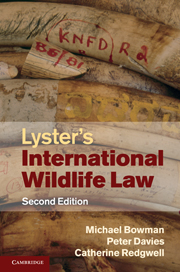Book contents
- Frontmatter
- Contents
- Foreword
- Preface
- List of abbreviations
- PART I Foundations of international wildlife law
- PART II Species regulation
- PART III Regional wildlife regulation
- 8 The Convention on Nature Protection and Wildlife Preservation in the Western Hemisphere
- 9 The African Convention on the Conservation of Nature and Natural Resources
- 10 The Convention on the Conservation of European Wildlife and Natural Habitats
- 11 Polar regions
- 12 Other regional and subregional arrangements
- PART IV Global wildlife regulation
- PART V Biological diversity: a new perspective on wildlife regulation
- PART VI Cross-sectoral issues in wildlife regulation
- PART VII Conclusion
- Index
- References
12 - Other regional and subregional arrangements
Published online by Cambridge University Press: 05 July 2011
- Frontmatter
- Contents
- Foreword
- Preface
- List of abbreviations
- PART I Foundations of international wildlife law
- PART II Species regulation
- PART III Regional wildlife regulation
- 8 The Convention on Nature Protection and Wildlife Preservation in the Western Hemisphere
- 9 The African Convention on the Conservation of Nature and Natural Resources
- 10 The Convention on the Conservation of European Wildlife and Natural Habitats
- 11 Polar regions
- 12 Other regional and subregional arrangements
- PART IV Global wildlife regulation
- PART V Biological diversity: a new perspective on wildlife regulation
- PART VI Cross-sectoral issues in wildlife regulation
- PART VII Conclusion
- Index
- References
Summary
Introduction
Efforts to establish international legal regimes for wildlife conservation in the Asian and the South Pacific regions, together with the adoption of four Specially Protected Area (SPA) protocols relating to the Caribbean, Eastern African, Mediterranean, and South East Pacific regions under the UN Regional Seas Programme, provide the focus for discussion in this chapter. These regional and subregional activities have met with varying degrees of success. In Asia, the 1985 Agreement on the Conservation of Nature and Natural Resources (the ASEAN Agreement) has still to enter into force, and in the South Pacific the operation of the 1976 Convention on Conservation of Nature in the South Pacific (the Apia Convention) has effectively been suspended since 2006. They nevertheless merit brief attention both as historical instances of law-making initiatives, and as practical indications of matters of concern within the regions in question. Furthermore, it is not completely inconceivable that they might be activated, or reactivated, in the future. On a more positive note, some encouraging progress has been made particularly in the Mediterranean and Caribbean in facilitating the establishment of protected areas under the Regional Seas Programme. The SPA protocols offer the prospect of contributing significantly to the management and conservation of wildlife within their own sphere of application.
- Type
- Chapter
- Information
- Lyster's International Wildlife Law , pp. 376 - 400Publisher: Cambridge University PressPrint publication year: 2010



